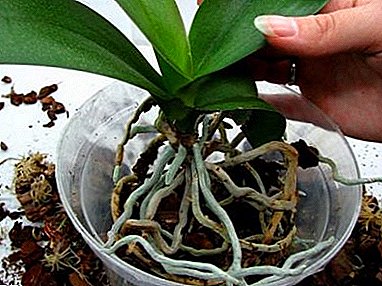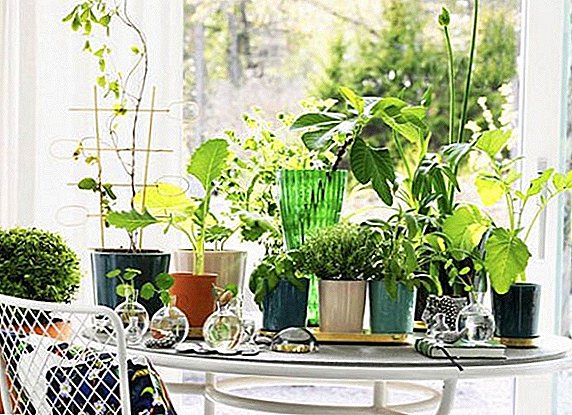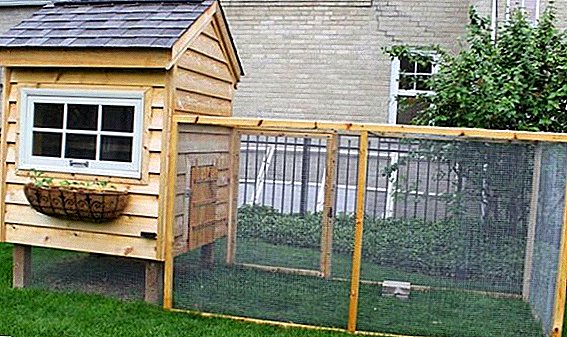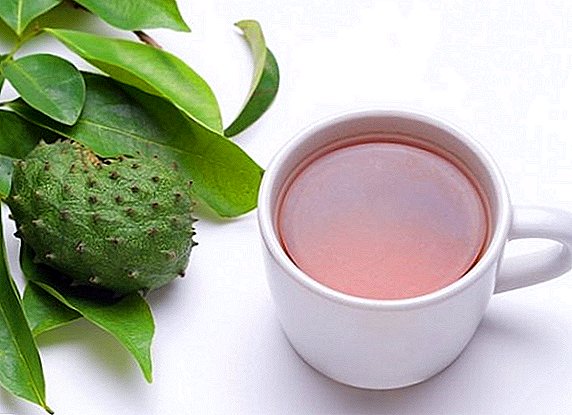
Orchid is a gentle and seductive flower that looks great in the interior of any room. The plant requires certain conditions and special care. Naturally transplant the plant should be timely.
But what to do if you gave a flowering plant, which has roots in its pots. It is clear that the pot is small, and the orchid needs to be transplanted. But is it possible to carry out such manipulations with a blooming specimen? Will the plant get sick after this?
Is it possible to transplant plants during flowering?
After buying it in the store
Often orchids stand in a store for a very long time, and the pot becomes small.. If the roots of a purchased plant stick out of a container, then it must be transplanted. It is necessary to act as carefully as possible - the orchid is a very fragile and tender plant.
Which is in the home for a long time
There are certain circumstances in which a transplant is urgently needed - this happens if the plant is sick and there is a choice, or beautiful flowers or the death of a specimen after flowering.
Is it worth doing this?
 This question cannot be answered unambiguously, since everything depends on the specific situation. For any plant, transplanting is stressful, especially during flowering.. So before you transplant a flowering plant, you need to weigh the pros and cons.
This question cannot be answered unambiguously, since everything depends on the specific situation. For any plant, transplanting is stressful, especially during flowering.. So before you transplant a flowering plant, you need to weigh the pros and cons.
And nevertheless, is it possible to repot an orchid after purchase, if it has released a flower stalk, how can it be transplanted to another pot and grow a flower during its growth?
It is understood that during flowering, the plant is greatly weakened and replanting it at this time you aggravate the situation to a critical. Consider the consequences that will negatively affect the orchid:
- if the transplant is done carelessly, the orchid will not only drop flowers, but may also die;
- the duration of flowering can be significantly reduced;
- the plant may not soon release the second flower spike;
- flower may stop growing and developing.
But the orchid transplant during flowering has certain advantages:
- if the plant is affected by pests, then this is a great opportunity to save it from death;
- if the pot has become small, then the transplant will help put the orchid in a more nutritious substrate, from which the leaf part will begin to grow and develop faster;
- the ability to protect the rest of the plants in the room from pests and infections.
Important: When a blooming orchid is being transplanted, the spike should be slightly shortened. Flowers, of course, will be less, but the rest will be large and bright, and the orchid will quickly release the next arrow.
Why is it unsafe for blooming beauty?
When an orchid blooms, it spends a lot of vitality in maintaining its inflorescences in a beautiful and lush state.. Therefore, before deciding to transfer a flower to another pot, consider whether it is worth the risk, as the plant may die.
Are there any exceptions to the rule?
Not only the orchid, but also other plants, experts do not recommend replanting in the period of rapid flowering. But sometimes this process is the only salvation for a flower.
At what point is it best to move the plant?
 If the orchid bought at the store is closely in the pot, numerous roots stick out of it, then you can immediately move the flower to a larger pots. If the orchid is transplanted neatly, without destroying the old earthy coma, it will easily transfer this procedure..
If the orchid bought at the store is closely in the pot, numerous roots stick out of it, then you can immediately move the flower to a larger pots. If the orchid is transplanted neatly, without destroying the old earthy coma, it will easily transfer this procedure..
If you need to perform the process of transplanting according to vital signs, it is better to cut the peduncle along the first sleeping bud. The plant will spend strength to restore and grow, and next time it will bloom more beautifully.
We recommend to watch a video about orchid transplanting after purchase:
When is it necessary to urgently change the earth and the pot?
There are several indicators on which the plant is transplanted on an emergency basis.:
- the flower struck the tick or it got sick;
- the roots have grown very much;
- because of the overmoistening of the soil, rotting of the root system began;
- When buying in a pot, there was a poor-quality substrate that was caked and did not allow the plant to eat properly;
- the leaves began to turn yellow;
- the leaf mass is several times larger in volume than the pot;
- roots are rooted in ceramic pots.
If the plant began to rot the roots, then the spike should be removed so that it has the strength to root. This transplant is very difficult, so you need to strictly follow the instructions.
If there are no above indications for transplantation, then it is better not to touch the orchid until the flowering stops. So the flower will avoid unnecessary stress and will not get sick.
We recommend to watch the video about the reasons for the urgent transfer of a blooming orchid:
Basic rules for the blooming orchid
So, it was decided to transplant the orchid in color. Consider how to do it correctly, and whether it is possible with minimal damage to the plant.
Training
Inventory and tools need to prepare in advance:
- garden shears or small pruner;
- antibacterial solution or activated carbon;
- substrate;
- drainage;
- plastic pot of the right size.
Pot
 Flowerpot for orchids to choose the right, only so the plant will develop well. There are orchid species that have roots taking part in photosynthesis, transparent pots are chosen for them. For the rest, you can choose any plastic or ceramic pots.
Flowerpot for orchids to choose the right, only so the plant will develop well. There are orchid species that have roots taking part in photosynthesis, transparent pots are chosen for them. For the rest, you can choose any plastic or ceramic pots.
To prevent water from stagnating at the bottom of the pot, there must be a sufficient number of holes.. No need to immediately choose a pot with a "stock" - in this case, the orchid will begin to intensively increase the green mass, and you will not wait for flowers.
When purchasing ceramic pots, you need to choose specimens glazed from the inside, so the roots will not grow to the pot. If possible, buy a pot on the leg, so the plant will receive a sufficient amount of oxygen, and excess moisture will quietly drain through the holes.
We recommend to watch a video about choosing a pot for orchids:
Priming
The substrate is prepared based on the conditions of detention:
- if the orchid is in a room with dry air, then the ground should be as moisture-consuming as possible;
- good soil should dry out completely in 3-4 days;
- besides this, the substrate must be very light and not clod.
If you decide to prepare the substrate yourself, it is better to take pine bark, sphagnum moss, a little peat and charcoal. Do not take the bark from a tree that has long been lying on the ground - it should be fresh. In addition, before applying it must be boiled.
- After boiling, the bark is well dried and divided into 2 parts: one is broken into large fragments, the other is well ground.
- Moss for a day is placed in water at room temperature.
- Peat and coal need a little, only to feed the plant after transplanting.
As soon as the mixture is ready, it should be disinfected by soaking for 2 hours in a weak solution of potassium permanganate. Next, the finished substrate need a little dry.
We recommend to watch the video about the preparation of soil for orchids with your own hands:
Step-by-step instruction
- Before you pull the plant out of the old pot, you need to shorten all the flower stalks, about 3 cm. In this case, rooting will be faster, and the plant will give lateral flower stalks soon.
 Before transplanting the orchid is well shed, carefully tap the pots on the sides and take out the roots along with a clod of earth. Ceramic pot should be carefully broken.
Before transplanting the orchid is well shed, carefully tap the pots on the sides and take out the roots along with a clod of earth. Ceramic pot should be carefully broken.- Often the roots of an orchid grow to a clay pot - an attempt to tear off a plant will lead to its death. Do not remove the clay shards stuck to the roots, planted along with them. Plastic pot can be cut.
- Clean the root system of the old substrate as carefully as possible. You can soak earthy clod with roots for 30 minutes in warm water. After which the roots are washed in running water.
- Carefully inspect the root system, blackened, rotted fragments cut off with shears or scissors - they must first be disinfected.
- All places of cuts need to be powdered with charcoal or other disinfecting composition. You can apply brilliant green.
- Then the orchid is left for 6 hours to dry. At this time, prepare the substrate and the pot.
- If the reason for transplanting a plant is an overgrown root system, then you should choose a larger size pot. If the reason is different, then the pot take the same volume.
Board: If an old pot is used, then it must be washed and disinfected with a dark solution of manganese, then dried.
- Drainage should be laid on the bottom of the pot, approximately 1/3 of the pots.
- Fill in a handful of substrate, then lower the orchid roots together with the support stick, and carefully fill the missing ground. To seal it is not necessary to press the ground, as you can damage the delicate roots, it is enough just to knock a little on the edges of the pot, so that the substrate can settle.
- Tie flower stalks to the support peg.
We recommend to watch the video about the correct transplanting of a blossoming orchid:
First watering
After transplantation, the plant is not watered, the substrate after soaking and so wet. The flower is placed in a warm place with diffused light and allowed to recover for about 2-3 days, only after that the orchid is watered.
We recommend to watch the video about the first watering of orchids after transplantation:
What to do if pests are still found?
If, after washing the root system, pests were detected, then you need to prepare an antimicrobial composition and lower the roots in it for 5 minutes.
How to provide care after the procedure?
After orchid transplanting, special care is needed.:
 air temperature must be maintained no more than +20 degrees;
air temperature must be maintained no more than +20 degrees;- do not put a flower in the sun for 10 days - the light should be scattered;
- on day 4, you can water the plant with a small amount of water that is boiled before watering;
- re-watering is carried out on day 14;
- the orchid responds well to irrigation, but it needs to be done only with boiled water;
- after 30 days, you can feed the orchid, potash and nitrogen fertilizers for the first time.
Conclusion
The question of whether it is possible to replant an orchid during flowering can be definitely answered - yes. But only with urgent need. It is worth remembering that the orchid is a very delicate plant that requires the utmost care. Transplanting during flowering is a great stress for an orchid, so you need to act very carefully to save her life.


 Before transplanting the orchid is well shed, carefully tap the pots on the sides and take out the roots along with a clod of earth. Ceramic pot should be carefully broken.
Before transplanting the orchid is well shed, carefully tap the pots on the sides and take out the roots along with a clod of earth. Ceramic pot should be carefully broken. air temperature must be maintained no more than +20 degrees;
air temperature must be maintained no more than +20 degrees;









